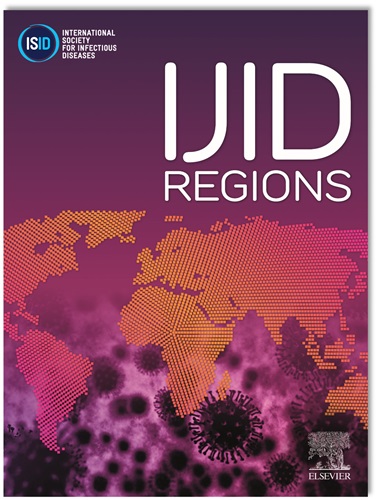Disseminated Mycobacterium simiae infection causing rhinosinusitis in a severely immunocompromised patient
IF 4.3
2区 医学
Q1 INFECTIOUS DISEASES
引用次数: 0
Abstract
Objectives
Mycobacterium simiae is a slow-growing environmental nontuberculous mycobacterium (NTM), commonly isolated from soil and water. M. simiae is not known to transmit zoonotically or via human-to-human contact; infection is presumed to occur through direct environmental exposure. Although M. simiae represents a small proportion of NTM isolates globally, its clinical relevance is increasingly recognized. Extrapulmonary manifestations are rare, and to date, no cases of rhinosinusitis attributable to M. simiae have been reported.
Case presentation and management
A 33-year-old male with advanced HIV (cluster of differentiation 4⁺ count 6 cells/µL), who completed tuberculosis treatment 2 months prior to the current admission, presented with right eye proptosis, pain, restricted ocular movement, nasal discharge, and fever. Three weeks earlier, he was hospitalized and discharged for chronic diarrhea complicated by acute-on-chronic kidney injury and pancytopenia. Imaging showed sinus opacification with bony erosion extending into the orbit. Cultures from blood and sinus aspirate identified Mycobacterium simiae, confirmed by line-probe assay. Despite multidisciplinary care, minimal improvement occurred, and he died 2 weeks after admission.
Conclusions
This case represents the first documented instance of M. simiae-associated rhinosinusitis and highlights the pathogenic potential of environmental NTM in causing destructive and disseminated disease in severely immunocompromised patients.
播散性猴分枝杆菌感染引起严重免疫功能低下患者的鼻窦炎。
背景:猴分枝杆菌是一种生长缓慢的环境非结核分枝杆菌(NTM),通常从土壤和水中分离出来。已知猿猴支原体不会通过人畜共患或人与人之间的接触传播;假定感染是通过直接接触环境而发生的。尽管猿支原体在全球NTM分离株中只占一小部分,但其临床相关性已日益得到认可。肺外表现是罕见的,到目前为止,没有病例鼻鼻窦炎归因于猴分枝杆菌已被报道。病例介绍和处理:一名33岁男性,患有晚期人类免疫缺陷病毒感染(HIV) (CD4 +计数6个细胞/µL),在本次入院前两个月完成结核病治疗,表现为右眼突出、疼痛、眼球运动受限、流鼻液和发烧。三周前,他因慢性腹泻并发急性慢性肾损伤和全血细胞减少症住院并出院。影像显示窦性混浊伴骨侵蚀延伸至眼眶。血液和鼻窦抽吸培养鉴定为类人猿分枝杆菌,经线探针法证实。尽管进行了多学科治疗,但改善甚微,他在入院后两周死亡。结论:该病例是第一例有文献记载的猴分枝杆菌相关性鼻窦炎病例,突出了环境NTM在严重免疫功能低下患者中引起破坏性和播散性疾病的致病潜力。
本文章由计算机程序翻译,如有差异,请以英文原文为准。
求助全文
约1分钟内获得全文
求助全文
来源期刊
CiteScore
18.90
自引率
2.40%
发文量
1020
审稿时长
30 days
期刊介绍:
International Journal of Infectious Diseases (IJID)
Publisher: International Society for Infectious Diseases
Publication Frequency: Monthly
Type: Peer-reviewed, Open Access
Scope:
Publishes original clinical and laboratory-based research.
Reports clinical trials, reviews, and some case reports.
Focuses on epidemiology, clinical diagnosis, treatment, and control of infectious diseases.
Emphasizes diseases common in under-resourced countries.

 求助内容:
求助内容: 应助结果提醒方式:
应助结果提醒方式:


